Raspberry Insect and Mite Pests
Raspberry Insect and Mite Pests
Epilachna beetle/ Hadda beetle/Spotted leaf beetle
Spotted beetles are distributed from East Asia to South Asia and Australia. They are polyphagous, and feed predominantly on cucurbits, brinjal, potato, and kidney bean as well as eggplant. These beetles are considered to be one of the most serious groups of pests damaging eggplant. In addition, they also feed on other solanaceous plants such as S. nigrum, S. xanthocarpum, S. torvum, Datura sp., Physalis sp. and Withania somnifera (L.).
Biology
E. vigintioctopunctata (in Latin, viginti means 20 and octo means 8) has 28 black spots on the forewing (elytra). E. dodecastigma (dodecam means 12 in Greek) has 12 black spots on the elytra. However, beetles with 14, 16, 18, 20, 22, 24 or 26 spots have been observed under field conditions, due to mating between females of E. dodecastigma and males of E. vigintioctopunctata.
- Egg: The females lay eggs mostly on the lower leaf surfaces. Each female lays about 100-400 eggs. The egg is spindle-shaped and yellowish in color. Eggs are laid in clusters of 10-40. The egg period varies from two to five days.
- Pupa: The pupa resembles the grub but is mostly darker in color, although it sometimes is yellowish in color. The pupa bears spiny hairs on the posterior, but not the anterior, part of the body. The pupal period is one to two weeks.
- Adult: The subfamily Epilachninae contains plant-feeding ladybird beetles because most other ladybird beetles are predators, not plant pests. These brownish or orange- colored, hemispherical beetles are larger than other ladybird species.
Life cycle
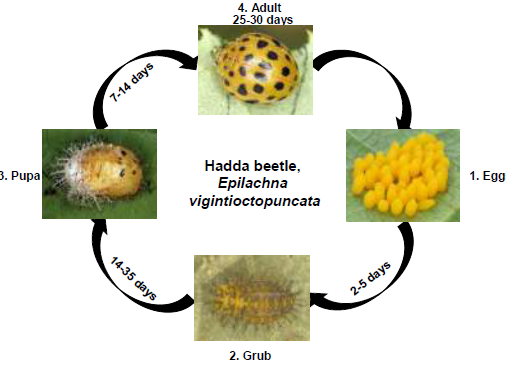
Damage symptoms:
- The grub and adult have chewing mouthparts. Hence, they scrape the chlorophyll from
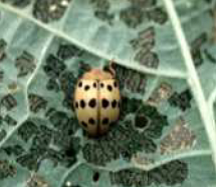 the epidermal layers of the leaves
the epidermal layers of the leaves - The feeding results in a typical ladder-like window. The windows will dry and drop off, leaving holes in the leaves. In severe infestations, several windows coalesce together and lead to skeletonization - the formation of a papery structure on the leaf
Natural enemies
- Parasitoid: Larval and adult:Pediobius foveolatus
- Predators : Reduviid bug/ assassin bug, Pentatomid bug,
Fruit borer
Biology
- Eggs : Eggs are spherical, dome-shaped with a flat base, 0.5 mm in diameter, yellowish and turn brownish as the embryo develops. They are laid singly on tender leaves and take 2-4 days for hatching.
- Larvae : Full grown larva may be green, pale yellow, pale brown or greyish but always with a dark stripe on the lateral sides of the body. Body also bears inconspicuous tubercles and scattered small hairs. There are 6 larval instars and the entire larval development takes 20-25 days.
- Pupa : Pupation takes place in the soil. Pupal period is 10-15 days. Moths emerge and make their way through the soil.
- Adults : Adult moths are medium sized, with a wing span of 3-4 cm. They are extremely variable in colour from buff to light brownish to greyish-brown, marked with dark greyish irregular lines on the fore wing and a broad blackish band near the outer margin. Hind wing is dull whitish in colour, with outer margin broadly black. Sometimes there is a dark spot in the middle of fore wing.
Life cycle:

Damage symptoms:
- They feed on leaves and tender shoots and bore into the fruits
- Fungus and other diseases follow in the damaged fruits. One larva may feed on several fruits before completing development
Cut worm
Adult cutworm and armyworm moths appear between April and July.
Biology
- Egg:Females lay about 500 eggs on lower grass leaves over a 2- to 3-week period.
- Larvae: Armyworms feed for 3 to 4 weeks, and are full grown at 1½ to 2”long. Armyworm larvae have 6 growth stages, or instars. The final instar lasts about 10 days.
- Pupae:Some species overwinter as a naked pupa in the soil, while some continue to develop through winter. Duration of the pupal stage is normally 12 to 20 days.
- Adults:The adult preoviposition period is about seven to 10 days. Adult period varies around 10-20 days.
Life cycle:
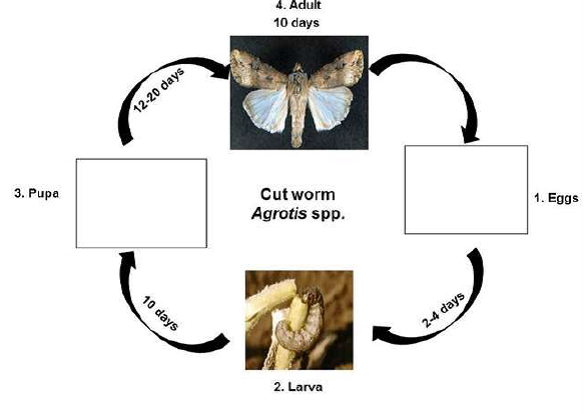
Damage symptoms:
- Early season cutworms are a rare problem.
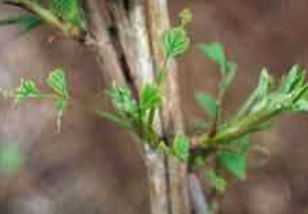
- Cutworms and armyworms are the caterpillars of several species of night-flying moths. Plump, smooth and often, greasy-looking with greenish, brownish, grayish, or striped bodies up to 1 ¾”long, cutworms curl up tightly when disturbed. About the same size, armyworms are plump, sparsely-haired, and generally green to brown with dark longitudinal stripes running down the sides and back. Armyworms lay white or greenish eggs masses that darken as they near hatching.
Predators: Lacewing, Lady beetle, Spider, Fire ant, Dragon flies, Robber fly, Reduviid bug, Praying mantis, Black drongo, Wasp, Common mynah (King crow), (Geocoris sp), Big-eyed bug, Earwig, Ground beetle, Pentatomid bug
Red spider mite
Adult mites are 0.3-0.5 mm, greenish-yellow with two dark spots on the back. Nymphs are similar in appearance only smaller. Eggs are clear and round. All stages occur predominantly on the lower leaf surface.
Biology
Female two-spotted spider mites overwinter in crop debris on the ground. The overwintering adults are orange in colour. In spring they move to new growth and feed on leaves closest to the ground. There are many generations per year and eggs, nymphs, and adults are frequently present at the same time. As populations build and leaves age or become damaged, mites move up the plant to newer, more succulent growth. The time for one generation to develop, from egg to mature adult, ranges from to five days at 24ºC to three weeks at 12ºC.
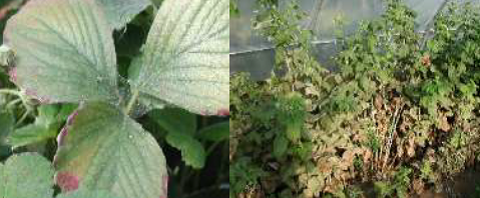
Damage symptoms:
- Stippling on leaves
- Webbing and defoliation
Predators: Predatory mites, Predatory thrips and Oligota spp
Aphids
Aphids may be green, black, brown, red, pink, or some other color depending on the sap color of the host plant. They are usually slow-moving insects with pear-shaped bodies ranging from 1 /16 to 1 /8 inch long. There may be various sizes of wingless aphids (nymphs and adults) in a dense colony on a stem, on the underside of the foliage, or on the flowers.
Biology
The life history of aphids is somewhat complicated and varies with the species. The simple life cycle is as follows: Overwintering eggs on branches and stems hatch in the spring to produce a wingless form known as the stem mother. The unfertilized stem mother gives birth to living young in great numbers. Several generations may occur in this fashion, but in due time some individuals will develop wings (alates) and migrate to another host. Here they may deposit eggs for the winter or, after a few generations, migrate back to the original host to lay eggs.
Life cycle:
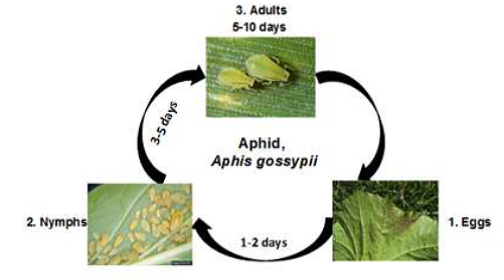
Damage symptoms:
- Aphids are sucking insects that feed by thrusting a long beak into
 the plant tissue.
the plant tissue. - They withdraw great quantities of sap, some of which they execrete as "honeydew".
- The honeydew makes the plant sticky. When trees are heavily infested with aphids, sidewalks, lawn furniture, and automobiles may become wet with honeydew.
- A sooty mold often develops with the honeydew blackening stems and foliage.
- This fungus is not parasitic to the plant, but reduces the amount of photosynthetic area.
- Leaves of plants may be distorted by aphids feeding on the undersides.
- Succulent stems may wilt or growth may be arrested by colonies of aphids. On the other hand, damage caused by aphids feeding on the bark of trees or woody shrubs cannot be readily seen.
Natural enemies
- Nymphal and adult parasitoids: Aphidius colemani, Aphelinus spp.
- Predators: Syrphid larva
IPM for Raspberry
To know the IPM practices for Raspberry, click here.
Source: NIPHM Directorate of Plant Protection, Quarantine & Storage
Last Modified : 4/2/2020
This topic provides information about Curryleaf Pe...
This topic covers information about Ber Insect and...
This topic covers information about Amla Insect Pe...
This topic covers information about Cucurbitaceous...
